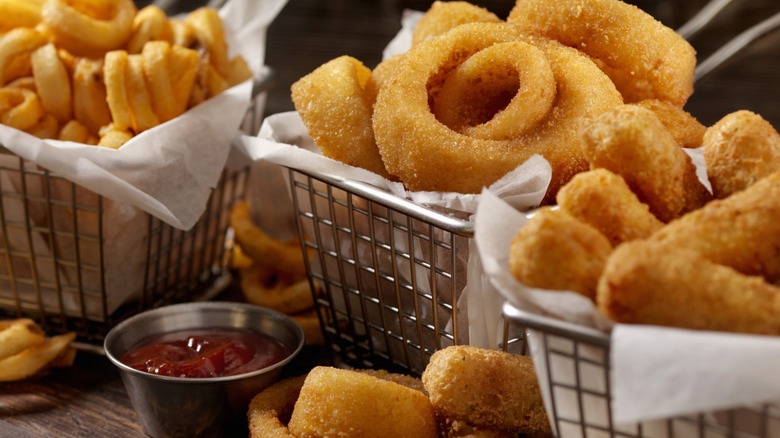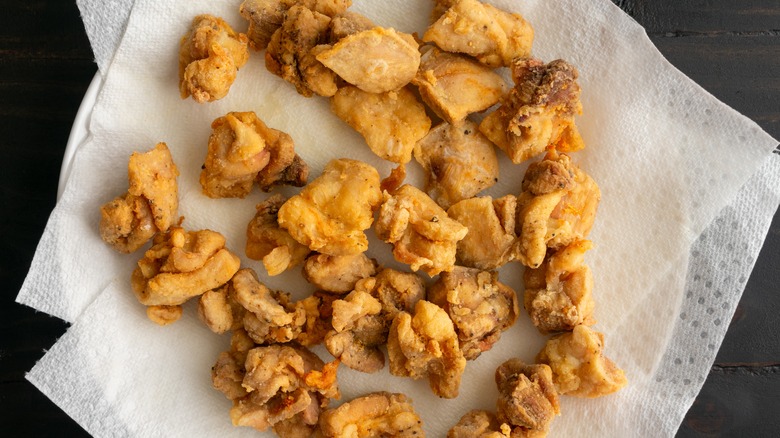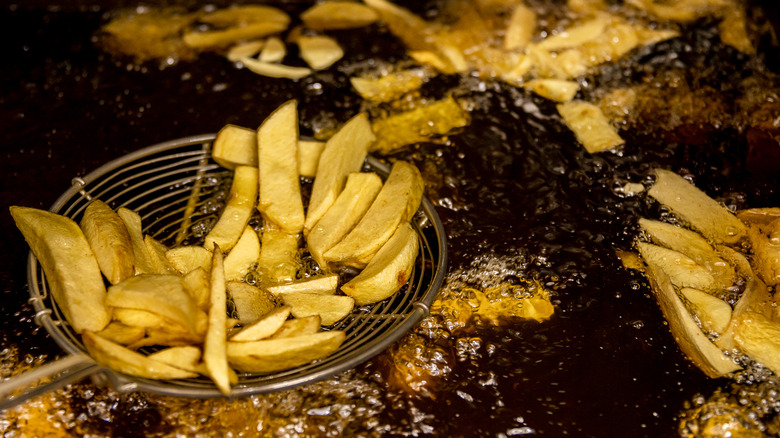Why You Should Absolutely Never Touch The Fried Foods At The Buffet
If you enjoy an all-you-can-eat buffet from time to time, there's no doubt that one of the keys to making it an enjoyable experience is strategizing what to put on your plate to get the most out of your buffet experience. When you first roll in, it's easy to be distracted by the stacks of fried chicken, egg rolls, tater tots, and other deep-fried foods. These are not where you want to concentrate your efforts, though. Fried foods are not the best value in terms of cost, flavor, or nutrition. For these reasons, we recommend going light on them or skipping them altogether when you're in the buffet line.
Of course, fried food is absolutely delicious and not something that you should avoid at all costs. All things in moderation, right? However, deep-fried food is one of the easiest ways for buffets to lure you into eating low-quality, cheap food, leaving you full and less than satisfied. After you chow down on a couple of greasy, heavily battered fish fillets and some sesame chicken, how many more plates can you really go back for? Additionally, the fried foods available at buffets may simply not be that good because the buffet model itself doesn't support the precise preparation, cooking, and timing needed to make fried foods delicious. Fried foods are also often given the worst quality of all because it's hard to distinguish nuanced flavors between the layers of oil and crunchy batter, unlike more barebones chicken breast or roasted potatoes.
Fried food requires precise timing
Ever ordered fried food from a takeout joint, only to have it arrive soggy and lukewarm? That is what can happen to fried food just in the time between being cooked and delivered to your door. Now imagine what happens to the fried chicken thighs and doughnut holes that spend hours under a glass dome and heating lamp. They'll quickly lose their optimal texture and temperature. It's just not possible for fried food to stay crispy, flavorful, and hot in buffet conditions. You're getting stuck with a low-quality meal.
Beyond the deterioration of the flavor and texture, other timing issues come along with buffets. A lot of places don't properly cook food in the deep fryer, leaving it undercooked, and then allowing the food to sit out in trays for hours on end. That leaves the food susceptible to bacterial growth. Anyone who's fried chicken at home knows that it can be difficult to get a golden crusty exterior and a tender but fully cooked center. Because buffets are working in bulk, the chefs likely aren't taking a thermometer to the center of each piece, which can increase the chances of poorly cooked food. Improper cooking is an issue that extends beyond chicken. Even if fried items are cooked properly, they are often left to stew without being changed out frequently enough, which is another way to invite food pathogens in. According to the USDSA, rapid bacterial growth occurs in cooked foods within two hours.
When the craving strikes
Another key reason to avoid fried foods at the buffet is simple; the ingredients aren't likely to be all that great. The majority of all-you-can-eat buffets are only able to turn a profit because they use the cheapest ingredients possible. That means each potato wedge, chicken wing, and onion ring is made with low-quality ingredients, right down to the oil they're fried in.
If you find yourself craving fried food from the buffet, despite our warnings, there are tips to follow so you can get the most out of a buffet's fried options. First, spring for a decent buffet. All-you-can-eat specials for a bargain basement price are unbelievably tempting but always be sure to ask yourself how it can possibly turn a profit with such low prices. It's almost certainly because of the quality of the ingredients and the food. So if you're ready to spring for a day at the buffet, try to choose a moderate to high-end option. Some high-end places will even fry food made to order only which eliminates a lot of the cons of buffet fried food.
You can also be sure to get fresh fried food if you're willing to be patient. Don't run up to the fried food offerings and stack your plate straight away. Take a few minutes to observe. If a tray is nearly empty, it's likely to be replenished fairly soon. Wait until you see a fresh batch of your desired food come out, then enjoy.


